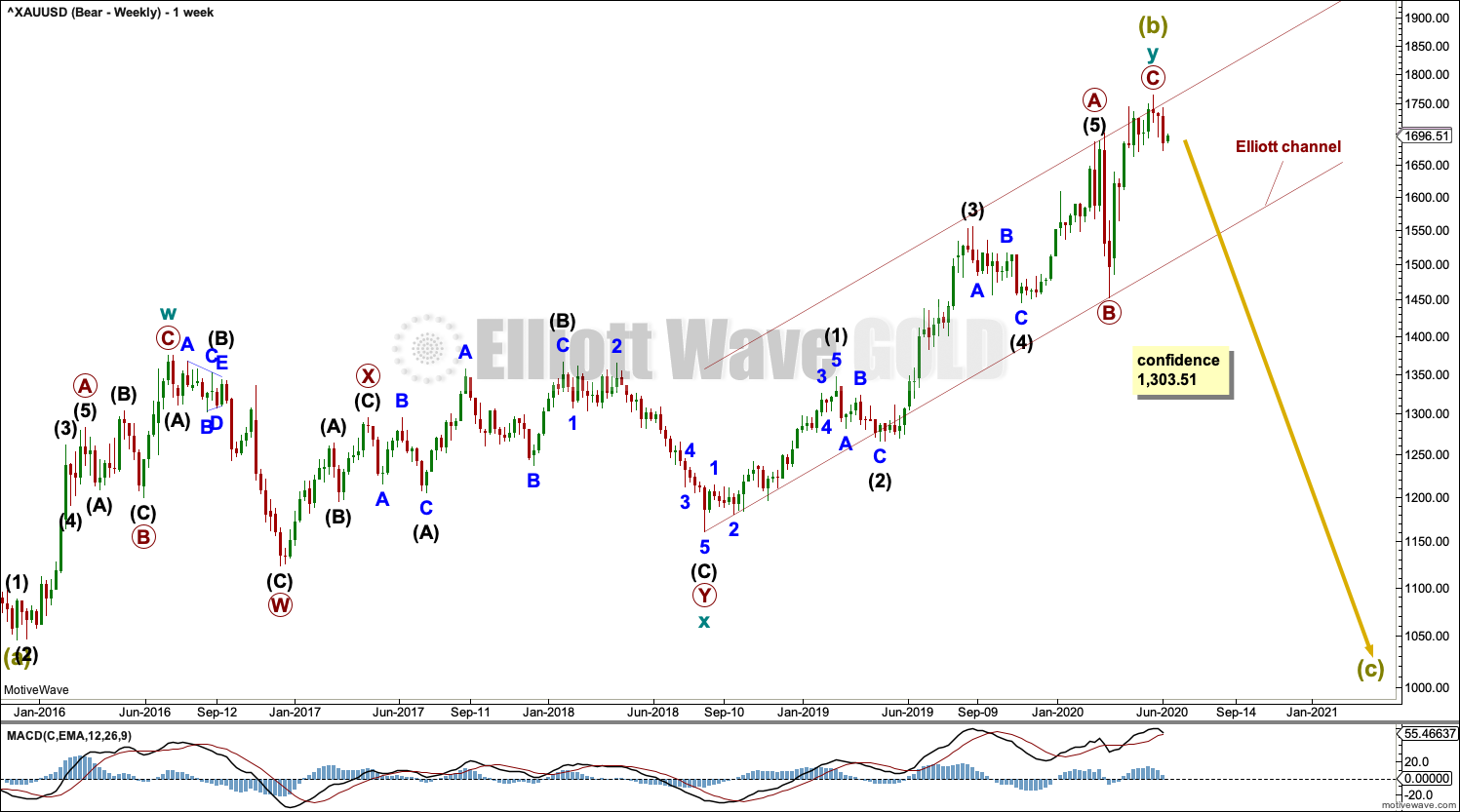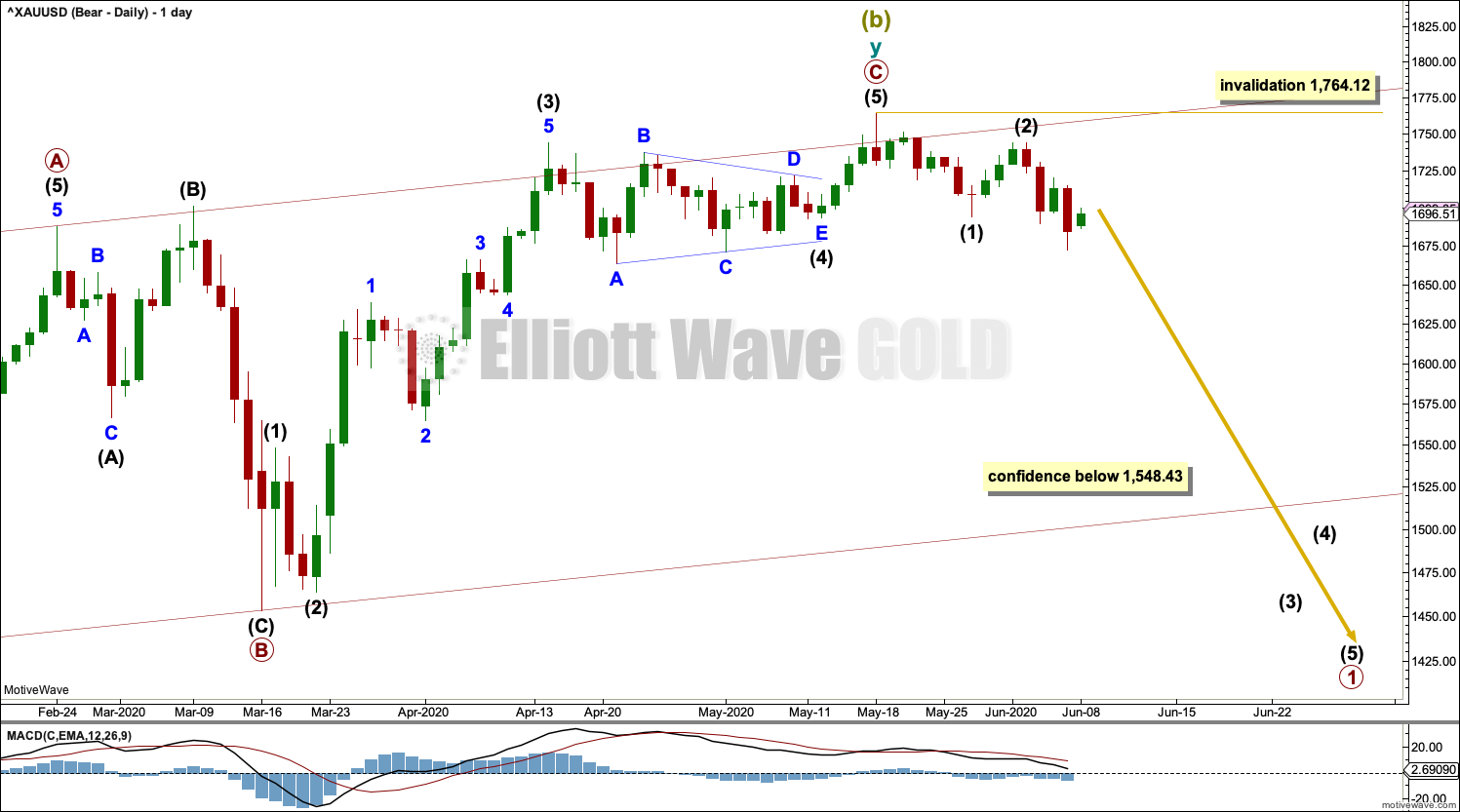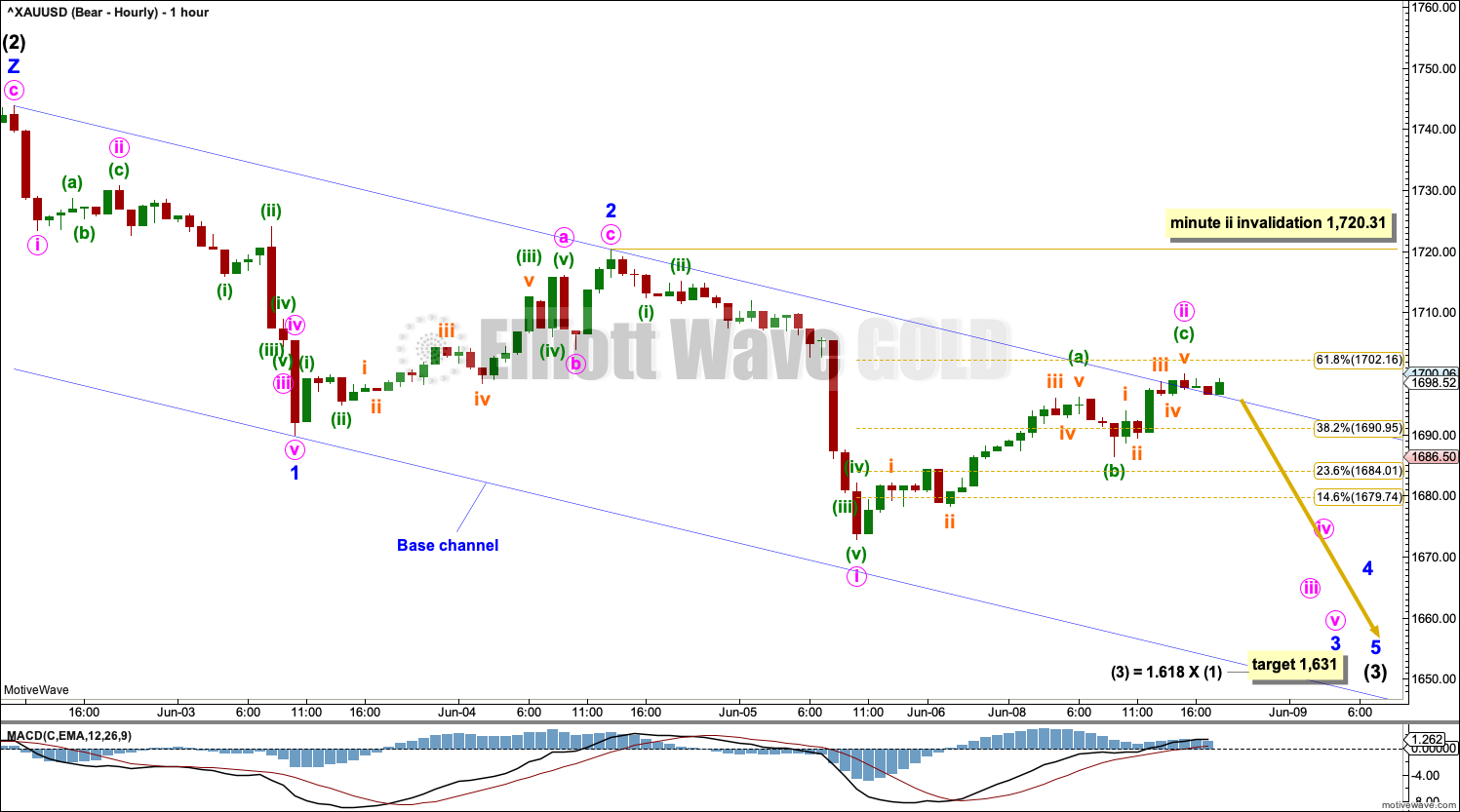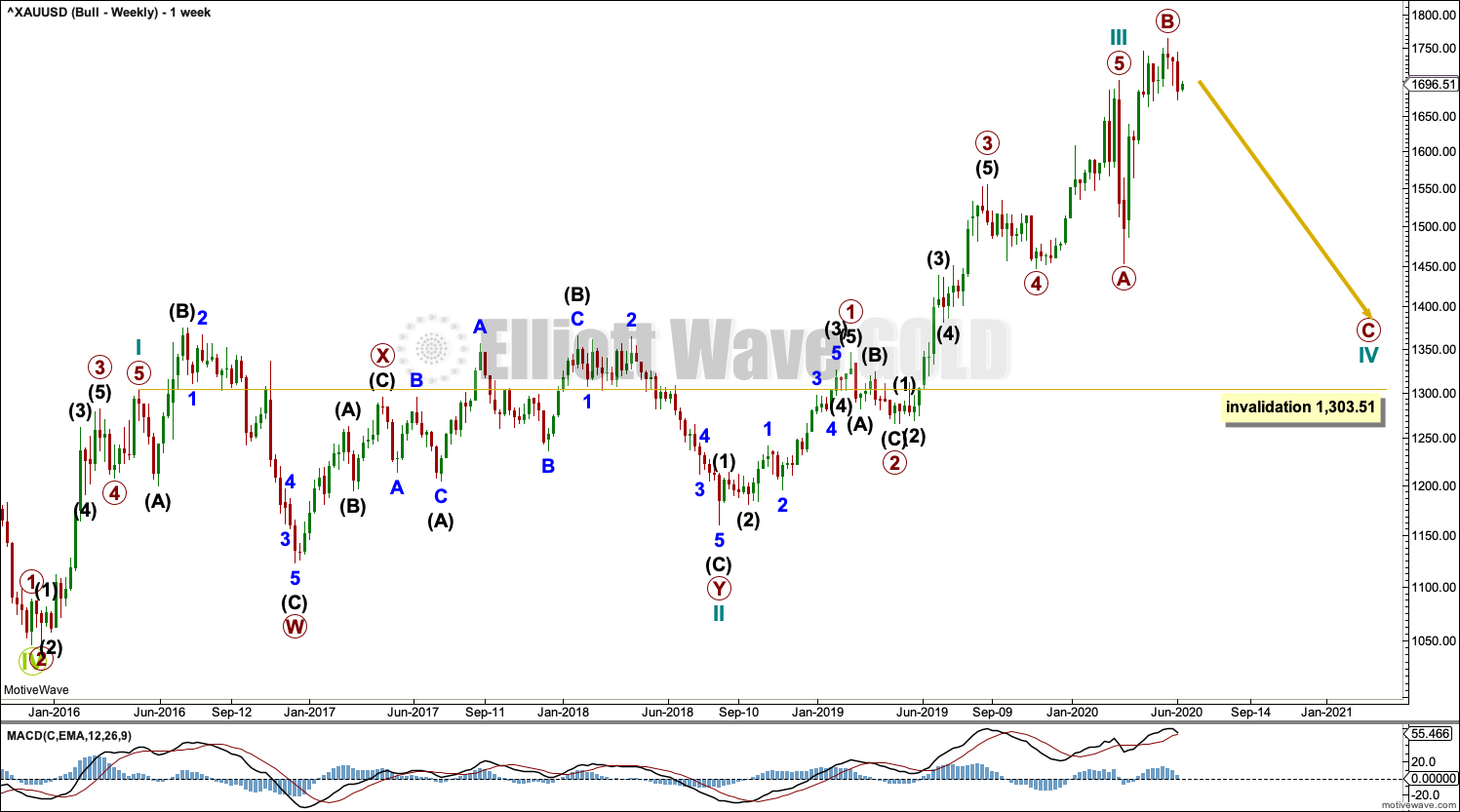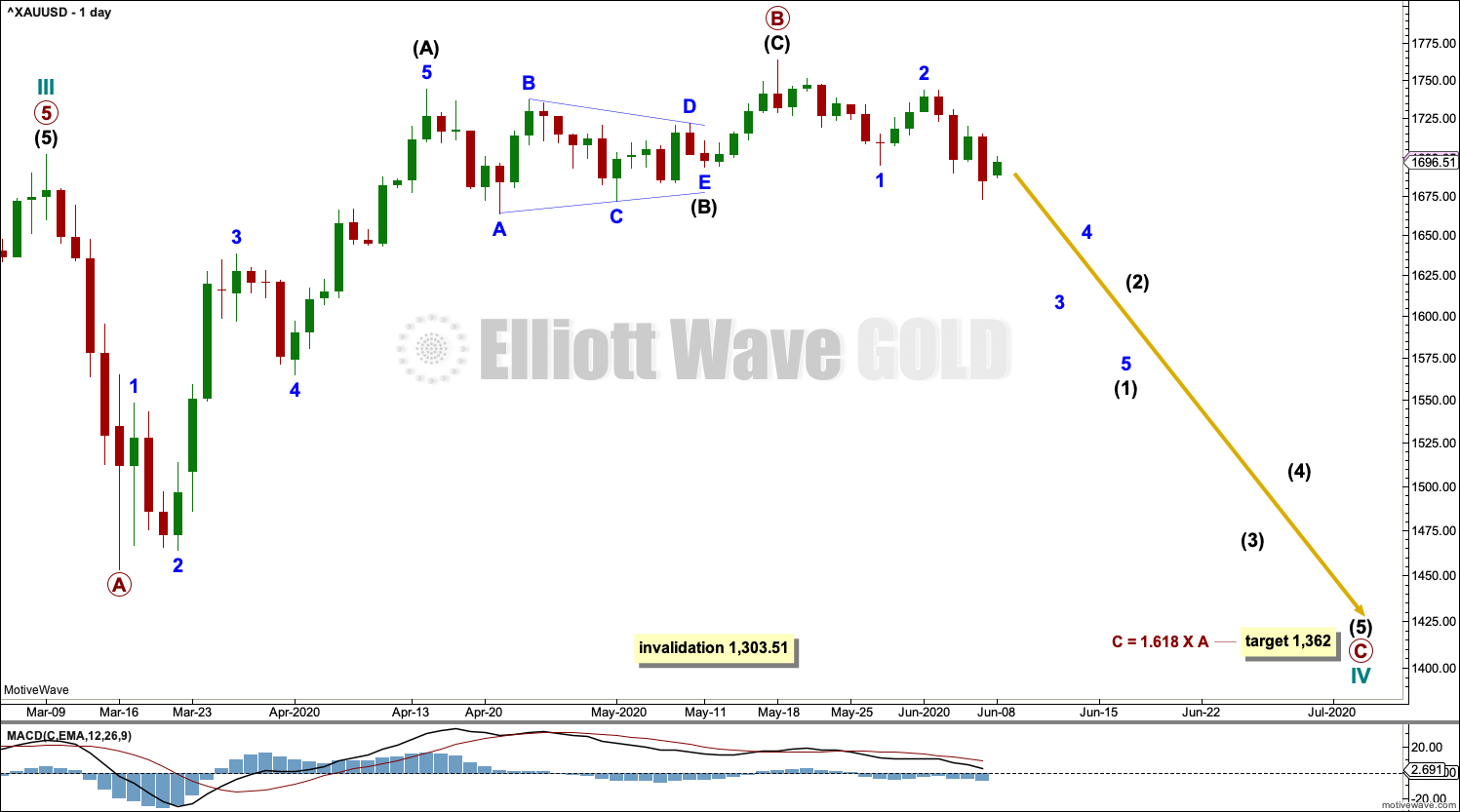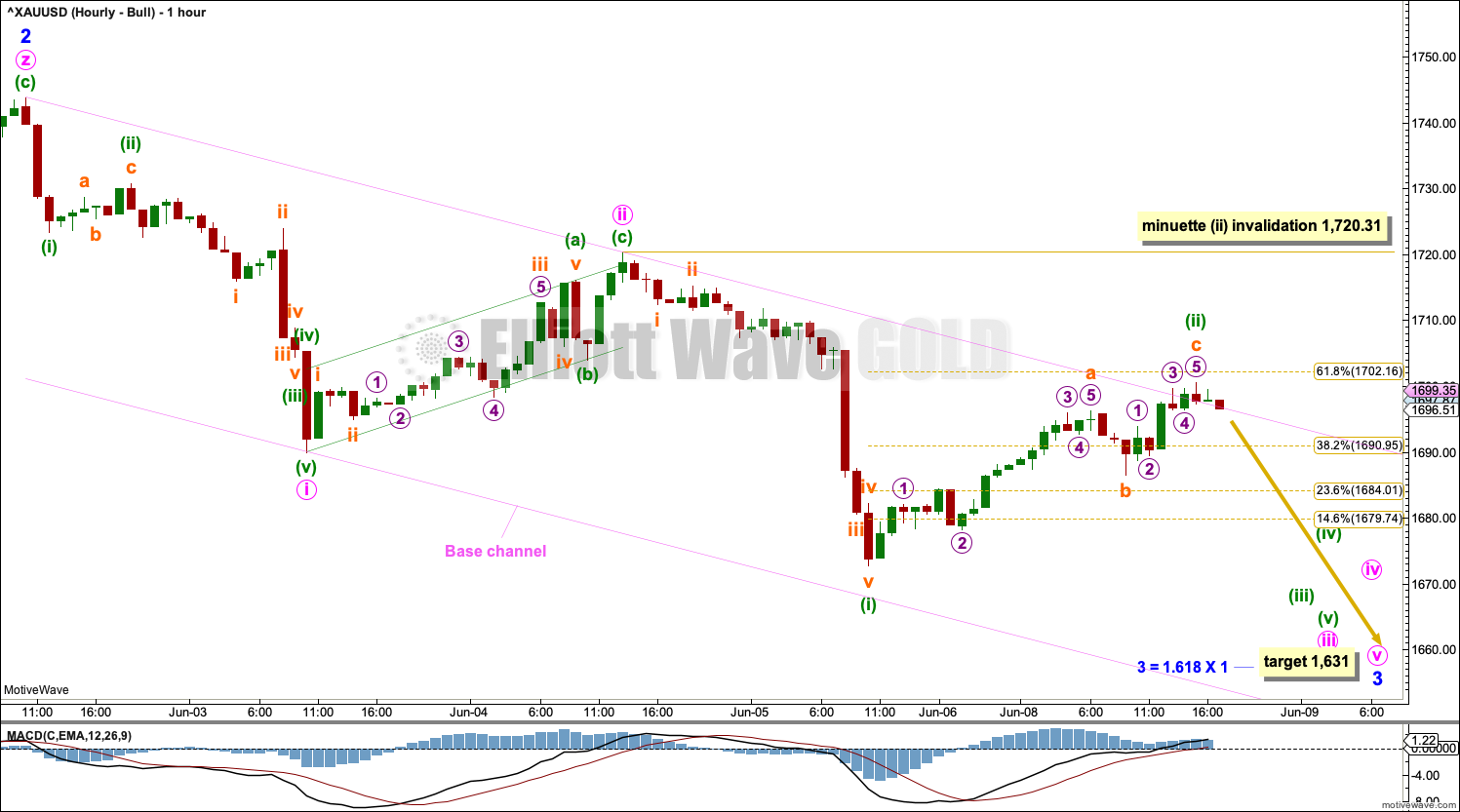GOLD: Elliott Wave and Technical Analysis | Charts – June 8, 2020
An inside day leaves all Elliott wave counts the same. The volume profile still supports the main Elliott wave count.
Summary: Expect continuing downwards movement to at least 1,362.
Further confidence in a downwards trend may be had if price makes a new low below 1,548.43.
A new high above 1,764.12 would indicate an upwards breakout. The target would then again be at 1,980.
Grand SuperCycle analysis is here.
Monthly charts were last updated here.
MAIN BEARISH ELLIOTT WAVE COUNT
WEEKLY CHART
The bigger picture for this main bearish Elliott wave count sees Gold as still within a bear market, in a three steps back pattern that is labelled Grand Super Cycle wave IV on monthly charts.
Super Cycle wave (b) within Grand Super Cycle wave IV may be a complete double zigzag.
The first zigzag in the double is labelled cycle wave w. The double is joined by a three in the opposite direction, a combination labelled cycle wave x. The second zigzag in the double is labelled cycle wave y.
The purpose of the second zigzag in a double is to deepen the correction. Cycle wave y has achieved this purpose.
Super Cycle wave (c) downwards may continue to complete the larger (a)-(b)-(c) correction for Grand Super Cycle wave IV. Super Cycle wave (c) would be very likely to move below the end of Super Cycle wave (a) at 1,046.27 to avoid a truncation. When the bullish alternate wave count is invalidated, then a final target may be calculated for Super Cycle wave (c).
DAILY CHART
Primary wave C within cycle wave y may be a complete five wave impulse.
A new low below 1,693.39 has added initial confidence to this wave count. A new low below 1,548.43 would invalidate a new more bullish alternate wave count (see below), so it would add further confidence to this main wave count.
When primary wave 1 is complete within the new downwards trend, then primary wave 2 may not move beyond the start of primary wave 1 above 1,764.12.
HOURLY CHART
Intermediate wave (3) may only subdivide as an impulse. Minor waves 1 and 2 within the impulse may be complete.
Minor wave 3 may only subdivide as an impulse. Minute wave i within the impulse may be complete. Minute wave ii may now also be complete as a single zigzag, finding resistance about the upper edge of the base channel. If it continues higher as a double zigzag, then minute wave ii may not move beyond the start of minute wave i above 1,720.31.
Draw a base channel about minor wave 3 as shown. The upper edge may provide resistance. The lower edge may be breached by the strength of the middle of a third wave.
ALTERNATE DAILY CHART
It remains possible that primary wave C may be an incomplete five wave impulse.
Within the impulse: intermediate waves (1) through to (3) may be complete and intermediate wave (4) may have continued lower as a double zigzag. Intermediate wave (4) may not move into intermediate wave (1) price territory below 1,548.43.
An Elliott channel is drawn about primary wave C. Primary wave C does not fit well within this channel, which slightly reduces the probability of this wave count.
ALTERNATE BULLISH ELLIOTT WAVE COUNT
WEEKLY CHART
This wave count sees the the bear market complete at the last major low for Gold on 3 December 2015.
If Gold is in a new bull market, then it should begin with a five wave structure upwards on the weekly chart.
Cycle wave I fits as a five wave impulse with reasonably proportionate corrections for primary waves 2 and 4.
Cycle wave II fits as a double flat. However, within the first flat correction labelled primary wave W, this wave count needs to ignore what looks like an obvious triangle from July to September 2016 (this can be seen labelled as a triangle on the bear wave count above). This movement must be labelled as a series of overlapping first and second waves. Ignoring this triangle reduces the probability of this wave count in Elliott wave terms.
Within the first flat correction labelled primary wave W of the double flat of cycle wave II, intermediate wave (B) is 1.69 the length of intermediate wave (A). This is longer than the common range of up to 1.38, but within an allowable guideline of up to 2. The length of intermediate wave (B) reduces the probability of this wave count.
Cycle wave III may be complete. Cycle wave IV may not move into cycle wave I price territory below 1,303.51.
DAILY CHART
Cycle wave IV may be an incomplete expanded flat correction. Primary wave A within the flat correction may have subdivided as a zigzag. Primary wave B may now be a complete zigzag. Primary wave B would be a 1.25 length of primary wave A. This is within the normal range for primary wave B within a flat from 1 to 1.38 times the length of primary wave A.
A target is calculated for primary wave C to end based upon the most common Fibonacci ratio to primary wave A within an expanded flat. Primary wave C must subdivide as a five wave motive structure.
It is still also possible that primary wave B could continue higher as a double zigzag. The common range of primary wave B would extend up to 1.38 times the length of primary wave A at 1,795.98. A maximum allowable guideline for primary wave B would be up to 2 times the length of primary wave A at 1,949.96. There is no Elliott wave rule stating a limit for B waves within expanded flat corrections, so there is no rule which may be used to determine an upper invalidation point for this wave count.
HOURLY CHART
Primary wave C must subdivide as a five wave motive structure, either an impulse or an ending diagonal. An impulse is more common, so that is what shall be expected.
Minor waves 1 and 2 within the new downwards trend may be complete.
Minor wave 3 may only subdivide as an impulse. Minute waves i and ii within minor wave 3 may be complete. Minute wave iii may only subdivide as an impulse. Minuette waves (i) and (ii) within minute wave iii may be complete. If it continues higher as as double zigzag, then minuette wave (ii) not move beyond the start of minuette wave (i) above 1,720.31.
TECHNICAL ANALYSIS
WEEKLY CHART
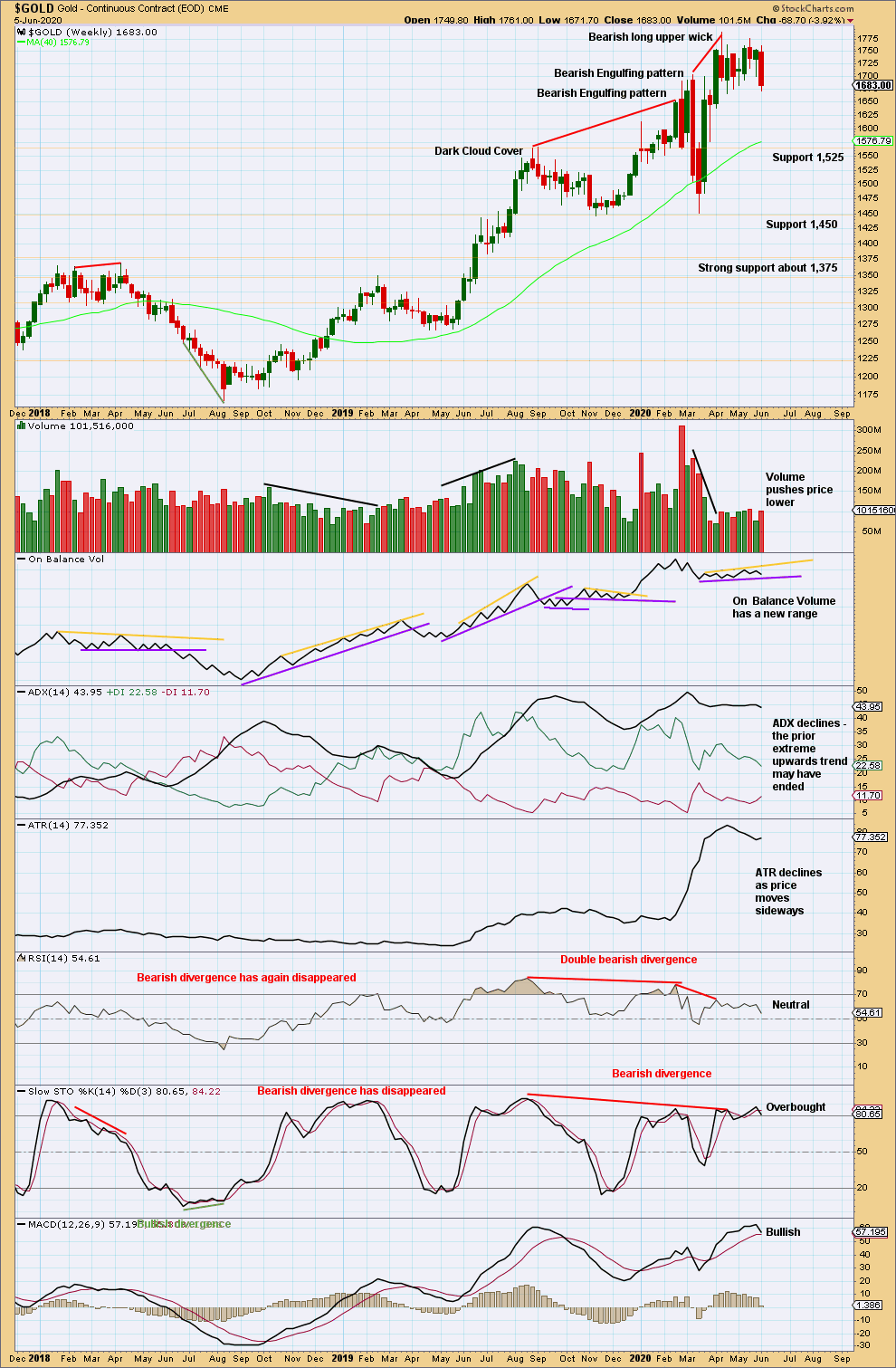
Click chart to enlarge. Chart courtesy of StockCharts.com.
Price remains within a consolidation with support about 1,665 to 1,680. Downwards movement dominated last week but has not managed to close below support. A push from volume for downwards movement last week suggests a downwards breakout may come soon.
DAILY CHART
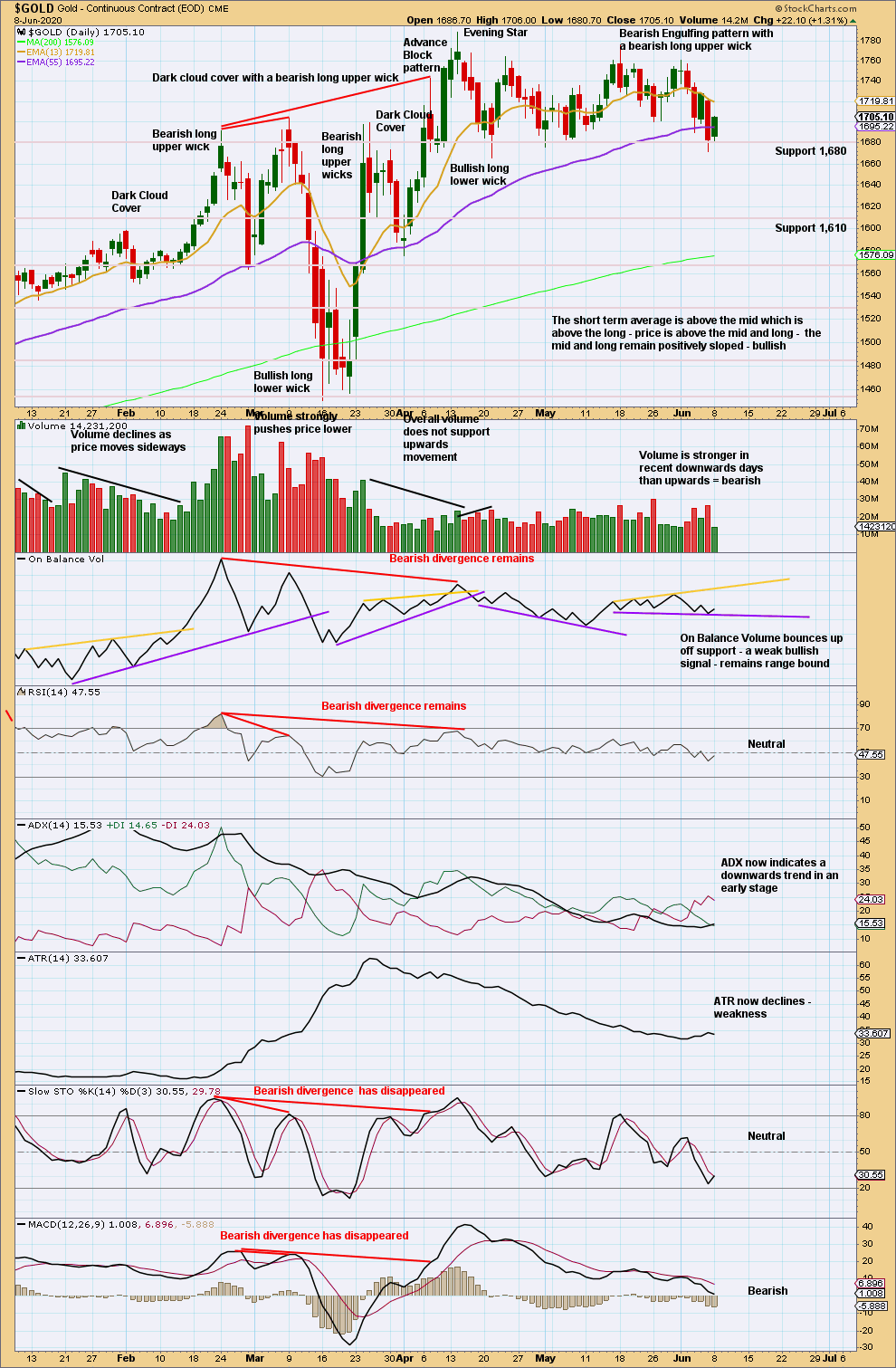
Click chart to enlarge. Chart courtesy of StockCharts.com.
With a bearish reversal pattern having support from volume on the 18th of May, the risk that price has changed trend here is high.
The short-term volume profile remains bearish. There is strong support here about 1,680.
GDX WEEKLY CHART

Click chart to enlarge. Chart courtesy of StockCharts.com.
Dark Cloud Cover is a bearish candlestick reversal pattern, but not the strongest reversal pattern (which are Engulfing patterns).
Some push last week from volume with downwards movement suggests more downwards movement ahead.
GDX DAILY CHART
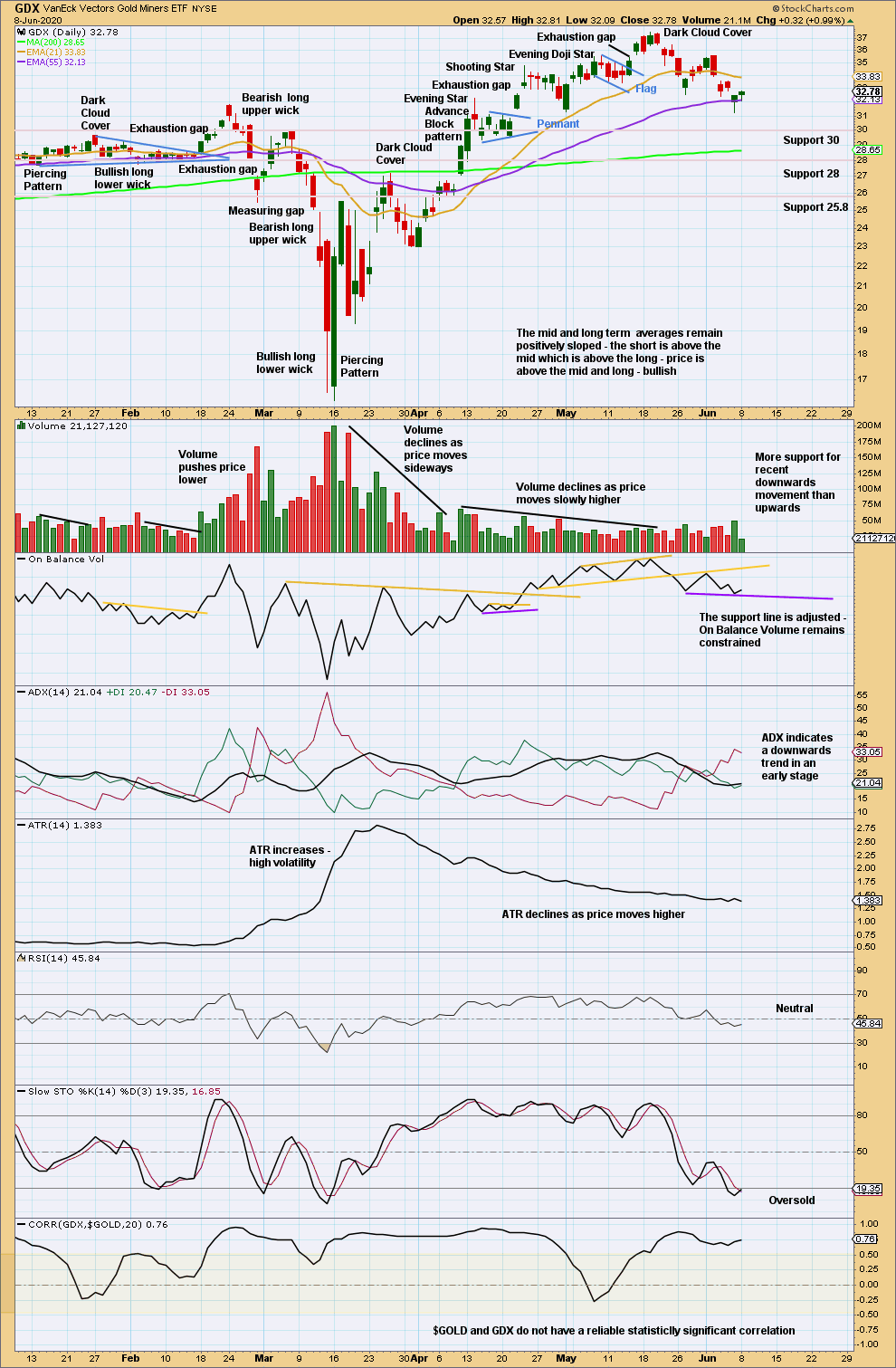
Click chart to enlarge. Chart courtesy of StockCharts.com.
The prior upwards trend reached extreme, but not very extreme. The last gap is closed, and a new swing low below 31.31 has now been seen. The evidence that GDX may have seen a trend change is now mounting. ADX now indicates a downwards trend in an early stage.
Upwards movement today leaves the last gap still open. Long lower wicks of the last two daily candlesticks suggest more upwards movement here, but a large decline in volume for upwards movement today is bearish for the short term. More weight may be given to volume in this instance.
Published @ 06:56 p.m. EST.
—
Careful risk management protects your trading account(s).
Follow my two Golden Rules:
1. Always trade with stops.
2. Risk only 1-5% of equity on any one trade.
—
New updates to this analysis are in bold.

